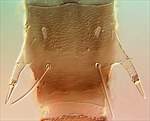
spectrum male

spectrum female

spectrum large & small males

spectrum pupae

spectrum larvae

spectrum male

dissimilis female

spectrum head

spectrum pronotum

spectrum pelta

spectrum tergite III

dissimilis tergite VIII
Generic diagnosis
Elongate, dark, macropterous Idolothripinae with males bearing lateral projections on abdomen. Head projecting slightly in front of eyes; 2 pairs of postocular setae, one behind the other; inter- and postocellar setae stout; genae with about 12 pairs of stout pale setae; maxillary stylets broad, V-shaped, low in head. Pronotal major setae well developed, anteroangulars close to midlaterals, epimera with 2 pairs of setae; notopleural sutures incomplete. Prosternal basantra weakly sclerotized; mesopresternum broad; metathoracic sternopleural sutures absent. Metanotal setae far apart, not enlarged. Fore tarsi with no tooth; fore femora external surface angulate, bearing a stout seta. Fore wing rather pointed apically, with more than 60 duplicated cilia. Pelta broad and trilobed; tergites with posterior angles weakly produced in females; males with tubercles laterally either on tergites III–VIII or only on VIII, each tubercle bearing apically a short stout seta, and these tubercles much larger in large males than in small males; tube longer than head and pronotum, bearing many lateral setae. Abdominal tubercles of males vary in number and size allometrically in association with body-size.
Nomenclatural data
Idolothrips Haliday in Walker, 1852: 1096. Type species Idolothrips marginatus Haliday (=spectrum), by subsequent designation of of Bagnall, 1908: 356.
Only two species are recognised in this genus; a third species that is listed from Okinawa, Japan is probably not congeneric. The Australian Giant Thrips, Idolothrips spectrum, has been described under a further seven names (ThripsWiki 2022).
Australian species
Idolothrips dissimilis Girault, 1927: 2.
Idolothrips spectrum Haliday in Walker, 1852: 1097.
Relationship data
This Australian genus is related to Bactrothrips in the Idolothripinae, Idolothripini, Idolothripina. It is similar in size and shape to the members of Mecynothrips in the Elaphrothripina, but has many setae laterally on the tube.
Distribution data
The two species in this genus are known only from Australia. One species, dissimilis, is known only from southeastern Queensland, but spectrum is widespread across Australia from Perth in Western Australia toTasmania, through much of southern Australia northwards through Queensland including Fraser Island and Cairns, to Darwin in Northern Territory.
Biological data
Nothing is known about dissimilis except that it has been found occasionally only in rain forests. However, spectrum is widespread across Australia forming colonies on the dry dead leaves of several Eucalyptus species and feeding by imbibing small pale fungal conidia.
References
Haliday AH (1852) Order III Physapoda. pp. 1094–1118 in Walker F List of the Homopterous insects in the British Museum Part IV. London: British Museum.
Mound LA (1974) Spore-feeding Thrips (Phlaeothripidae) from Leaf Litter and Dead Wood in Australia. Australian Journal of Zoology 27: 1–106.
ThripsWiki (2022) ThripsWiki - providing information on the World's thrips. Available from: http://thrips.info/wiki/ (Accessed 15.iii.2022)